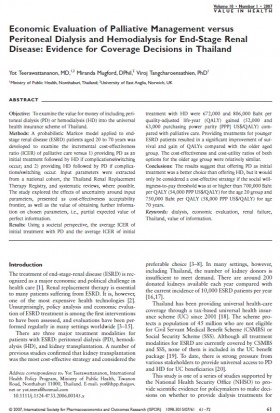This website uses cookies so that we can provide you with the best user experience possible. Cookie information is stored in your browser and performs functions such as recognising you when you return to our website and helping our team to understand which sections of the website you find most interesting and useful.
Economic Evaluation of Palliative Management versus Peritoneal Dialysis and Hemodialysis for End-Stage Renal Disease: Evidence for Coverage Decisions in Thailand (2007)

Details
Economic Evaluation of Palliative Management versus Peritoneal Dialysis and Hemodialysis
for End-Stage Renal Disease: Evidence for Coverage Decisions in Thailand
Yot Teerawattananon1 Miranda Mugford2 Viroj Tangcharoensathien1
1Ministry of Public Health, Nonthaburi, Thailand
2University of East Anglia, Norwich, UK
Objective: To examine the value for money of including peritoneal dialysis (PD) or hemodialysis (HD) into the universal health insurance scheme of Thailand.
Methods: A probabilistic Markov model applied to endstage renal disease (ESRD) patients aged 20 to 70 years was developed to examine the incremental cost-effectiveness
ratio (ICER) of palliative care versus 1) providing PD as an initial treatment followed by HD if complications/switching occur; and 2) providing HD followed by PD if complications/
switching occur. Input parameters were extracted from a national cohort, the Thailand Renal Replacement Therapy Registry, and systematic reviews, where possible.
The study explored the effects of uncertainty around input parameters, presented as cost-effectiveness acceptability frontier, as well as the value of obtaining further information
on chosen parameters, i.e., partial expected value of perfect information.
Results: Using a societal perspective, the average ICER of initial treatment with PD and the average ICER of initial treatment with HD were 672,000 and 806,000 Baht per
quality-adjusted life-year (QALY) gained (52,000 and 63,000 purchasing power parity [PPP] US$/QALY) compared with palliative care. Providing treatments for younger ESRD patients resulted in a significant improvement of survival and gain of QALYs compared with the older aged
group. The cost-effectiveness and cost-utility ratios of both options for the older age group were relatively similar.
Conclusions: The results suggest that offering PD as initial treatment was a better choice than offering HD, but it would only be considered a cost-effective strategy if the social willingness-to-pay threshold was at or higher than 700,000 Baht per QALY (54,000 PPP US$/QALY) for the age 20 group and 750,000 Baht per QALY (58,000 PPP US$/QALY) for age
70 years.
Keywords: dialysis, economic evaluation, renal failure, Thailand, value of information.
Link: http://www.valueinhealthjournal.com/article/S1098-3015%2810%2960455-X/abstract
http://onlinelibrary.wiley.com/doi/10.1111/j.1524-4733.2006.00145.x/abstract




